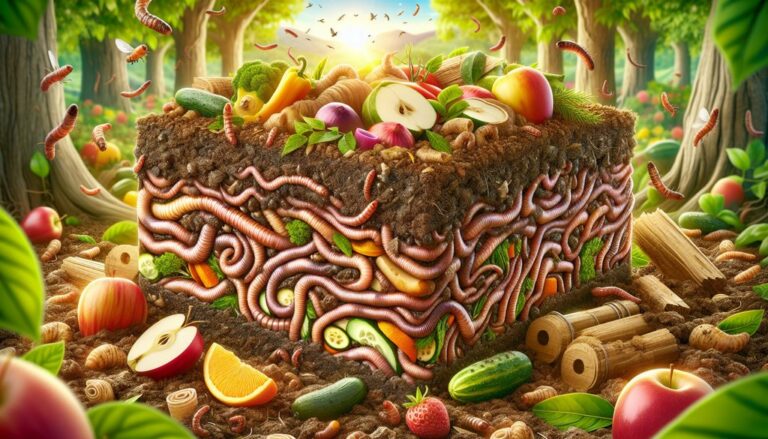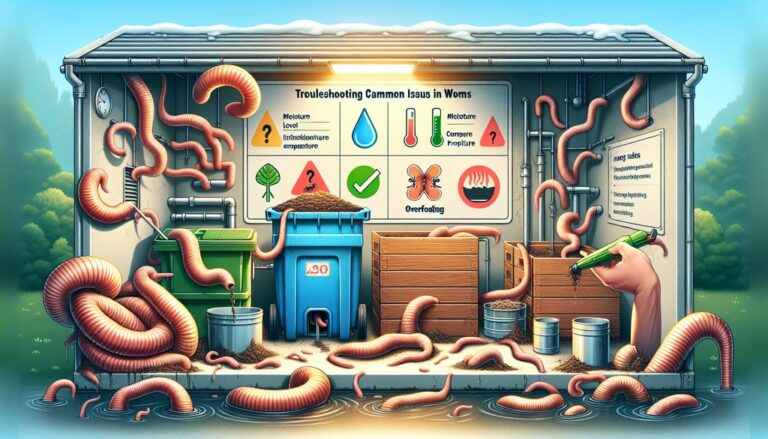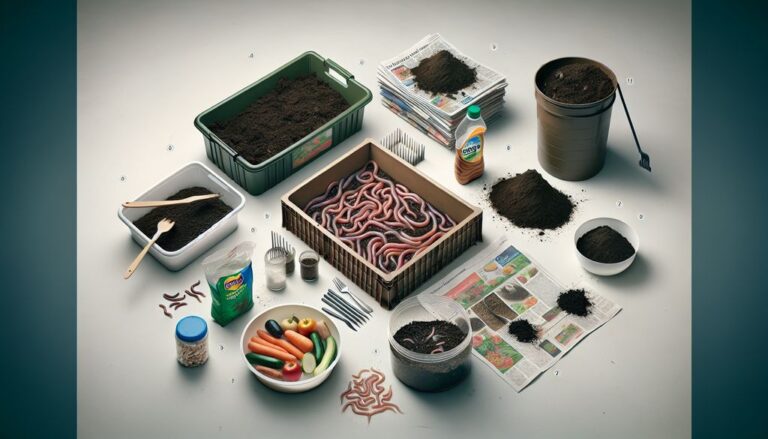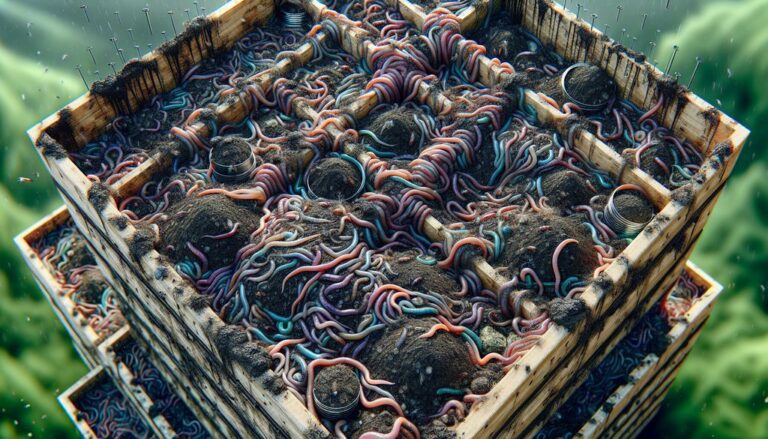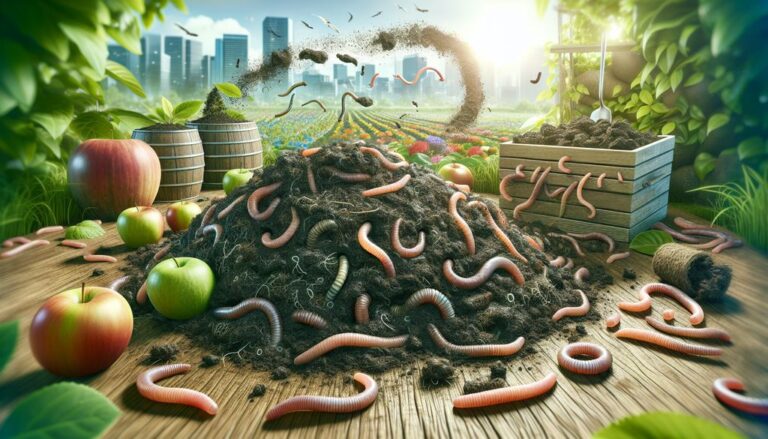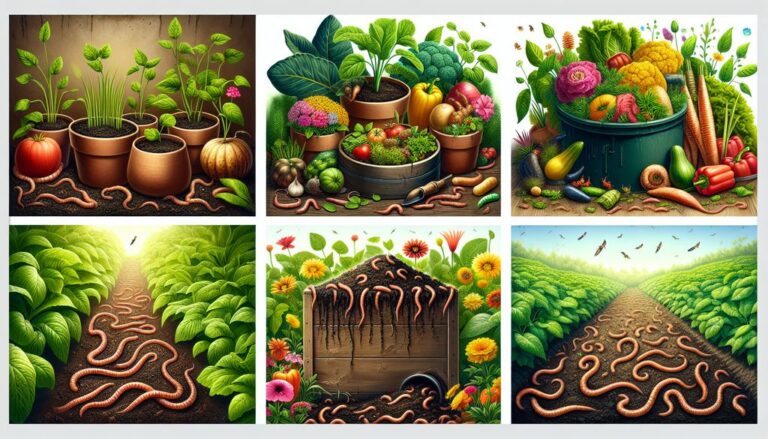Vermicomposting is the process of using worms to decompose organic material, such as kitchen scraps or garden waste, into nutrient-rich compost. It is an environmentally friendly way to recycle organic waste and produce natural fertilizer. In this article, we will explore 10 key facts about vermicomposting that will give you a deeper understanding of this sustainable practice. From the benefits of vermicomposting to the types of worms used, we will cover a range of topics to pique your interest and inspire you to take up this eco-friendly endeavor. So, whether you are new to vermicomposting or looking to expand your knowledge, buckle up and get ready to dive into the world of earthworms and decomposing organic matter!
Key Takeaways
- Vermicomposting is an environmentally friendly way to recycle organic waste and produce natural fertilizer.
- Red wiggler worms have a voracious appetite and can consume up to their own body weight in organic matter every day.
- Vermicomposting helps reduce the amount of organic waste going to landfills, decreases greenhouse gas emissions, and produces nutrient-rich compost that improves soil health and stimulates plant growth.
- With the help of red wiggler worms, organic waste can be broken down into nutrient-rich compost within a matter of a few months, significantly faster than traditional composting methods.
- Vermicomposting can be done on a small scale, using a simple worm bin in your backyard or even indoors, as well as on a larger scale for commercial composting operations.
What is Vermicomposting?
The Process of Using Worms
Vermicomposting harnesses the natural abilities of worms, particularly red wigglers, to break down organic waste into valuable compost. The worms consume kitchen scraps and garden waste, transforming them into a nutrient-rich substance that benefits the soil and plants. This process not only recycles waste but also reduces the need for chemical fertilizers, promoting a more sustainable way of living.
Vermicomposting is a simple yet effective method that can be done indoors or outdoors, making it accessible to everyone.
The basic steps of vermicomposting include:
- Setting up a worm bin with proper bedding material like shredded newspaper or cardboard.
- Adding worms, preferably red wigglers, to the bin.
- Feeding the worms with organic waste, avoiding meat, dairy, and oily foods.
- Maintaining the bin by keeping it in a cool, dark place and ensuring it remains moist.
- Harvesting the compost once the material is fully broken down.
By following these steps, you can create a sustainable cycle that not only disposes of waste responsibly but also enriches the environment.
Recycling Organic Waste
Vermicomposting transforms kitchen scraps and yard trimmings into valuable compost, diverting waste from landfills. Organic materials such as fruit and vegetable peels, coffee grounds, and shredded paper are ideal for worm bins. To maintain a healthy system, it’s crucial to exclude meat, dairy, and oily substances that can attract pests and cause odors.
Vermicomposting is an odorless process when managed properly, offering a clean and efficient way to recycle organic waste.
Here’s a simple guide to what you can include in your worm bin:
- Fruit and vegetable scraps
- Coffee grounds and tea bags
- Eggshells (crushed)
- Shredded newspaper and cardboard
- Yard trimmings (in moderation)
By following these guidelines, you can create a thriving environment for worms to work their magic, turning waste into a resource that benefits the soil and plants.
Producing Natural Fertilizer
Vermicomposting transforms kitchen scraps and yard waste into a valuable product: natural fertilizer. This fertilizer, often referred to as ‘worm castings’, is rich in nutrients essential for plant growth. It is a sustainable alternative to chemical fertilizers, offering a host of benefits for the soil and plants.
The natural fertilizer produced through vermicomposting contains not just nutrients, but also beneficial microorganisms that enhance soil health. These microorganisms help in breaking down organic matter, making nutrients more accessible to plants. Moreover, worm castings improve soil structure, increase moisture retention, and promote better root growth.
By using this natural fertilizer, gardeners and farmers can improve their soil’s fertility without the adverse environmental impacts associated with synthetic fertilizers.
Here are some of the key nutrients found in worm castings:
- Nitrogen (N): Promotes leaf growth and greener plants
- Phosphorus (P): Essential for root development and flowering
- Potassium (K): Important for overall plant health and disease resistance
- Calcium (Ca): Vital for cell wall structure and stability
- Magnesium (Mg): A central component of chlorophyll, necessary for photosynthesis
The Role of Red Wiggler Worms
Voracious Appetite
Red Wiggler worms, known scientifically as Eisenia fetida, are renowned for their voracious appetite. Capable of consuming their body weight in organic matter each day, these worms play a pivotal role in the composting process. Their diet consists of a variety of organic materials, including vegetable scraps, coffee grounds, and shredded paper.
- What Red Wigglers Eat:
- Vegetable scraps
- Coffee grounds
- Shredded paper
- Eggshells (crushed)
- Fruit peels
This appetite not only helps to break down waste quickly but also contributes to the production of high-quality compost. The efficiency of Red Wigglers in converting waste into nutrient-rich castings is a key factor in the success of vermicomposting systems.
The ability of Red Wiggler worms to process large amounts of waste makes them an invaluable asset in sustainable waste management practices.
Efficiency in Composting
Red Wiggler worms are renowned for their composting efficiency. They can consume up to their own body weight in organic matter every day, transforming waste into valuable compost in a short time frame. This rapid decomposition is much faster than traditional composting methods, which can take several months to over a year to produce usable compost.
Factors influencing the efficiency of vermicomposting include:
- The temperature of the environment
- The size of the worm population
- The types of organic materials provided
Vermicomposting is a low-maintenance process that yields high-quality compost. With the right conditions, it typically takes about 2-3 months to produce compost, making it a practical solution for waste management and soil enrichment.
The absence of foul odors is another testament to the efficiency of vermicomposting. Proper maintenance of the worm bin, such as avoiding overfeeding and ensuring adequate aeration, helps prevent any unpleasant smells, making it an ideal system for both indoor and outdoor settings.
Environmental Benefits
Vermicomposting offers a myriad of environmental benefits that extend beyond the garden. By reducing the need for chemical fertilizers, vermicomposting promotes a healthier ecosystem. Chemical fertilizers can lead to soil degradation and water pollution, whereas worm castings enrich the soil without the negative side effects.
- Reduction in Pesticides: Worm compost contains natural pest repellents, diminishing the need for harmful pesticides.
- Water Conservation: The improved soil structure from vermicompost increases water retention, reducing the need for frequent watering.
- Biodiversity: The process supports a diverse range of microorganisms, which are crucial for a robust ecosystem.
Vermicomposting is not just about waste management; it’s a step towards restoring the natural balance of our environment by nurturing the soil with what it truly needs.
Furthermore, the practice of vermicomposting can help combat climate change by reducing methane emissions from landfills. Organic waste in landfills decomposes anaerobically, producing methane, a potent greenhouse gas. When this waste is instead processed by worms, it decomposes aerobically, resulting in significantly less methane released into the atmosphere.
Benefits of Vermicomposting
Waste Reduction
Vermicomposting plays a pivotal role in waste management by transforming organic waste into a resource rather than letting it accumulate in landfills. This process significantly reduces the volume of waste, as worms can consume up to their own body weight in organic matter every day. The reduction of waste is not only beneficial for the environment but also for communities seeking sustainable waste solutions.
Vermicomposting aligns with sustainable practices by conserving resources and minimizing the need for chemical fertilizers, thus promoting a greener future.
The versatility of vermicomposting allows it to be adapted to various scales, from a small worm bin in a household to large commercial operations. Here’s a quick look at the types of waste suitable for vermicomposting:
- Fruit and vegetable scraps
- Coffee grounds and tea bags
- Shredded paper and cardboard
- Yard trimmings
It’s important to note that meat, dairy, and greasy food wastes should be avoided as they can attract pests and are not suitable for worm bins. By embracing vermicomposting, individuals and communities can make a positive impact on the environment.
Greenhouse Gas Emissions
Vermicomposting offers a significant advantage in the fight against climate change by reducing greenhouse gas emissions. Traditional composting methods can produce methane, a potent greenhouse gas, but the aerobic digestion process used by worms in vermicomposting does not. This is because worms require oxygen to live, and their activity promotes aeration, minimizing methane production.
Vermicomposting transforms waste into a resource while also protecting our atmosphere from harmful gases.
The following points highlight the environmental benefits of vermicomposting in terms of greenhouse gas emissions:
- Reduction of methane: By avoiding anaerobic conditions, vermicomposting prevents the creation of methane.
- Carbon sequestration: The compost produced can store carbon in the soil, keeping it out of the atmosphere.
- Lower energy use: Vermicomposting requires less energy compared to traditional composting methods, which often involve mechanical turning and transportation.
Soil Health Improvement
Vermicomposting contributes significantly to the enhancement of soil health. The addition of vermicompost to soil introduces essential nutrients and beneficial microorganisms. This natural amendment improves soil structure, increases moisture retention, and promotes overall plant health, leading to more robust and productive gardens and crops.
- Nutrient Enrichment: Vermicompost is rich in nitrogen, phosphorus, and potassium, which are vital for plant growth.
- Microbial Activity: The compost introduces beneficial bacteria and fungi that aid in nutrient absorption and disease resistance.
- Soil Structure: Regular addition of vermicompost can improve soil aeration and reduce compaction, making it easier for roots to grow.
- Moisture Retention: Enhanced soil structure leads to better water retention, reducing the need for frequent watering.
By integrating vermicomposting into gardening practices, individuals can play a pivotal role in creating a sustainable cycle that not only disposes of waste responsibly but also rejuvenates the earth beneath our feet.
Speedy Decomposition
Efficiency of Red Wiggler Worms
The red wiggler worms, known scientifically as Eisenia fetida, are celebrated for their remarkable efficiency in composting. They can consume up to their own body weight in organic matter every day, transforming kitchen scraps and garden waste into valuable compost in a short time frame. This rapid consumption rate is a key factor in the speedy decomposition process that makes vermicomposting so effective.
- Red wigglers thrive on a variety of organic materials, including fruit and vegetable scraps, coffee grounds, and paper.
- They are ideal for indoor composting systems due to their adaptability and non-invasive nature.
- Properly maintained worm bins are odorless and can be kept in small spaces, making them perfect for urban settings.
Vermicomposting with red wigglers is a sustainable practice that not only recycles waste but also produces high-quality compost, enriching the soil and supporting plant growth.
The efficiency of these worms is not just in their appetite but also in their ability to work continuously. Unlike traditional composting, which requires turning and can take months, vermicomposting is a more passive system that requires minimal intervention once set up.
Nutrient-Rich Compost
The compost produced through vermicomposting is not only beneficial for reducing waste but also for creating a nutrient-rich product that can greatly enhance soil quality. The presence of worms in the composting process leads to the production of vermicast, a type of compost that is teeming with essential nutrients for plants.
Vermicast, also known as worm castings, is the end-product of the breakdown of organic matter by the red wiggler worms. It is highly valued for its nutrient content and can include increased levels of nitrogen, phosphorus, and potassium, which are vital for plant growth.
- Nitrogen (N): Promotes leaf growth and is essential for photosynthesis.
- Phosphorus (P): Encourages root development and flowering.
- Potassium (K): Aids in overall plant health and disease resistance.
The nutrient profile of vermicast makes it an excellent amendment for garden soils and potting mixes, providing a sustainable and organic alternative to chemical fertilizers.
By using vermicomposting, not only are we recycling organic waste, but we are also creating a product that can help sustain plant life and restore soil vitality, closing the loop in an eco-friendly cycle.
Faster Decomposition Process
Vermicomposting, with the aid of red wiggler worms, accelerates the breakdown of organic waste into compost. This process can be completed in as little as 2-3 months, which is significantly quicker than traditional composting methods. Factors influencing the speed of decomposition include the temperature, the number of worms, and the types of organic materials provided.
- Fruit and vegetable scraps, coffee grounds, and paper products are ideal for vermicomposting.
- Meat, dairy, and greasy foods should be avoided as they can attract pests.
Proper maintenance of the worm bin is crucial for a successful and odorless vermicomposting experience. By providing the right environment and balanced food for the worms, they efficiently convert waste into a valuable resource for gardening and agriculture.
Vermicomposting not only offers a rapid solution to waste management but also contributes to the production of high-quality compost that benefits soil health and plant growth.
Vermicomposting at Any Scale
Small-Scale Vermicomposting
Small-scale vermicomposting is an accessible and convenient way to start composting with worms, especially for those with limited space. It can be done indoors using simple worm bins, making it ideal for apartment dwellers or those without a backyard. This method is not only easy to manage but also serves as a practical introduction to sustainable waste management.
To begin small-scale vermicomposting, you’ll need a few basic components:
- A worm bin or container with a lid
- Bedding material such as shredded newspaper or cardboard
- Red wiggler worms (Eisenia fetida)
- Organic waste like fruit and vegetable scraps, coffee grounds, and eggshells
Vermicomposting is relatively easy and low-maintenance. As long as you provide the worms with the right environment and proper food, they will do most of the work for you.
The process is straightforward: layer your bin with moist bedding, add worms, and then start feeding them your kitchen scraps. Over time, the worms will break down the waste, leaving behind rich, nutrient-dense compost. This compost can be used to enhance the soil in houseplants or garden beds, closing the loop on your organic waste.
Large-Scale Vermicomposting
Large-scale vermicomposting transforms vast quantities of organic waste into valuable compost, making it an essential practice for municipalities, institutions, and commercial agricultural operations. This method not only manages waste effectively but also contributes to the creation of a sustainable cycle of nutrients.
- Benefits of Large-Scale Vermicomposting:
- Reduces the amount of waste sent to landfills.
- Creates high-quality compost for agricultural use.
- Supports local food production by improving soil health.
- Can be integrated into existing waste management systems.
Large-scale vermicomposting systems can be tailored to the specific needs of a community or business, ensuring that the process is both efficient and environmentally friendly.
The scalability of vermicomposting allows it to be adapted to various settings, from small community gardens to large farming operations. With the right planning and management, large-scale vermicomposting can play a pivotal role in waste management and soil fertility strategies.
Adaptability to Different Needs
Vermicomposting is not a one-size-fits-all solution; it’s a flexible practice that can be tailored to meet various needs and circumstances. Whether you live in a small apartment or manage a large farm, there’s a vermicomposting system that can work for you.
For individuals or families wanting to reduce their kitchen waste, a simple bin under the sink may suffice. Schools and educational institutions might opt for medium-sized systems that serve as both waste management solutions and learning tools. On the other hand, agricultural operations can implement large-scale systems that turn significant amounts of organic waste into valuable compost.
- Small-scale: Ideal for personal or household use
- Medium-scale: Suitable for educational settings or community gardens
- Large-scale: Designed for agricultural or industrial applications
The beauty of vermicomposting lies in its scalability. You can start small and expand as you become more comfortable with the process or as your needs grow. This adaptability makes vermicomposting an accessible and practical component of sustainable living.
Vermicomposting can be started with minimal investment and space, making it an excellent entry point into sustainable practices for people from all walks of life.
Educational Value for Kids
Teaching Natural Cycle of Decomposition
Vermicomposting offers a hands-on experience for kids to learn about the natural cycle of decomposition. By observing worms at work, children can see firsthand how organic waste is transformed into valuable compost. This process not only demonstrates the breakdown of materials but also the role of organisms in recycling nutrients.
- Organic waste is added to the worm bin.
- Red wiggler worms consume the waste, breaking it down.
- The waste is converted into worm castings, a type of compost.
- Castings are harvested and used to enrich soil, completing the cycle.
Vermicomposting makes the abstract concept of decomposition tangible and relatable. It connects the dots between waste and renewal, showing how what is discarded can become a resource once again.
Understanding this cycle is crucial for fostering a sense of responsibility towards the environment. It encourages sustainable practices by highlighting how each stage of the cycle is interconnected and vital for maintaining a healthy ecosystem.
Role of Worms in Ecosystem
Worms play a crucial role in our ecosystem, particularly in soil health and fertility. Red wiggler worms, known scientifically as Eisenia fetida, are especially important in this process. They break down organic matter, turning waste into nutrient-rich compost that benefits plant growth.
- Soil Aeration: Worms tunnel through the soil, creating spaces for air and water to flow, which is essential for plant roots.
- Nutrient Cycling: As worms digest organic material, they produce castings rich in nutrients like nitrogen, phosphorus, and potassium.
- Improved Soil Structure: The movement of worms and their castings help bind soil particles together, improving texture and water retention.
Worms are nature’s recyclers, transforming waste into resources that support a healthy, thriving ecosystem.
By engaging in vermicomposting, we harness the natural abilities of worms to manage waste and enhance soil quality. This process not only reduces the amount of organic waste in landfills but also mitigates greenhouse gas emissions. Vermicomposting is a clear example of how small creatures can have a significant impact on environmental sustainability.
Importance of Recycling and Caring for the Environment
Understanding the importance of recycling and caring for the environment is crucial for the sustainability of our planet. Vermicomposting serves as a practical example of how individual actions can contribute to a larger environmental solution. By engaging in vermicomposting, we not only reduce the amount of waste sent to landfills but also create a valuable product that enhances soil health and supports plant growth.
Vermicomposting demonstrates the power of natural processes in waste management and highlights the significance of responsible consumption and waste disposal.
Here are some key benefits of recycling through vermicomposting:
- Reduces the volume of waste in landfills
- Lowers methane emissions from decomposing waste
- Provides a nutrient-rich soil amendment
- Encourages sustainable gardening practices
By teaching children the importance of recycling and environmental care through vermicomposting, we instill in them the values of stewardship and responsibility towards the Earth. It’s a lesson that goes beyond the classroom, fostering a lifelong commitment to environmental preservation.
Conclusion
In conclusion, vermicomposting is a fascinating and eco-friendly method of composting that utilizes worms to break down organic materials into nutrient-rich compost. Not only does vermicomposting reduce waste and landfill use, but it also provides a valuable source of natural fertilizer for plants and gardens. By following the vermiculture process and understanding the key facts about vermicomposting, you can easily incorporate this sustainable practice into your daily life.
Frequently Asked Questions
What is vermicomposting?
Vermicomposting is the process of using worms to break down organic materials, such as kitchen scraps and yard waste, into nutrient-rich compost.
What kind of worms are used in vermicomposting?
The most commonly used worms for vermicomposting are redworms (Eisenia fetida) or red wigglers. These worms are highly efficient in breaking down organic matter.
How does vermicomposting benefit the environment?
Vermicomposting helps reduce organic waste in landfills, where it would otherwise contribute to greenhouse gas emissions. It also produces high-quality compost that can be used for gardening, reducing the need for chemical fertilizers.
Can vermicomposting be done indoors?
Yes, vermicomposting can be done indoors in containers such as worm bins. It is a great option for those with limited outdoor space or living in apartments.
What are the benefits of vermicomposting?
Vermicomposting helps reduce the amount of organic waste going to landfills, decreases greenhouse gas emissions, and produces nutrient-rich compost that improves soil health and stimulates plant growth.
Is vermicomposting suitable for all scales?
Yes, vermicomposting can be done on a small scale, using a simple worm bin in your backyard or even indoors, as well as on a larger scale for commercial composting operations. It is a versatile method that can be adapted to different needs and available space.

